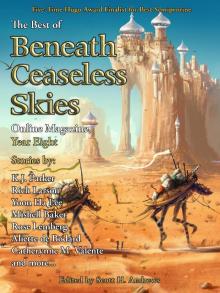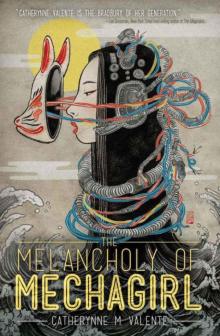


A Secret Quest, Page 9
J. A. Brimingham
For the first time in recorded imperial history, Emperor Tybus III mobilized the available military might of the Empire. He conscripted men and materials from all the provincial planets into the Imperial Defense Force (IDF) to meet the coming attacks head-on. These actions, however, were not enough to turn the tide. Even with more men and munitions, Alpheena struggled mightily against the Kiletican onslaught and many people perished. Centuries of peace had left the Empire's military lacking in both numbers and equipment. The Kileticans, on the other hand, were considered one of the more formidable powers in this region of the galaxy. Defeat and the loss of Alpheena seemed all but assured during the lowest points of the war.
But the longer the war dragged on, the more the Empire was able to mobilize its vast resources and pool them into a collective fighting force. New factories quickly sprang up across the provincial planets and older factories were re-dedicated to new military purposes. This era of history is credited with more advancements in stardrive technology than any other. Bigger and better ships with more armor and improved weaponry were soon being churned out of nearly every world within the Empire's borders.
By late 236 i.c. It was becoming apparent that the outcome of the war had been decided in the Empire's favor. However, the Kileticans attacks still proceeded almost without interruption. It was clear that a message needed to be sent in order to bring both sides to the bargaining table.
As the Cycle turned to 237 i.c., the Empire launched its first campaign into Kiletican space. The initial assault took the Kileticans by surprise and three of their outposts were captured in only the first cycle. This indeed was enough to initiate talks of a truce and finally bring about an end to the hostilities. On the seventeenth of Danibas, 237 i.c., the Accadian Peace Accords were signed by representatives of both governments, officially ending the war.
The Results of War - the dawning of the Golden Age ( 240 i.c. - 300 i.c. ): With the defeat of the Kileticans, The Durantalian Empire was now viewed as both a major economic player and a military power in the region. Her clout with other races quickly rose and more favorable trade deals were stuck which greatly benefited the already growing empire. No longer did the other races look upon mankind as a sort of novelty. In addition, never again would the IDF be so neglected. While the numbers would swell and subside over time, the IDF would always be a force to be reckoned with. With the rapid expansion of the Empire and her newly-found status, humans were now observed with both amazement and suspicion. The Empire would now be taken seriously by all parties.
-Purduay enters the Empire ( 301 i.c. - 310 i.c.): With the events of the war still fresh in the minds of the Empire's populace, it was decided that another planet be given provincial status. Purduay was chosen not only because of its growing colony and settlements, but because of its strategic position. Purduay was the outer-most planet the Empire had yet colonized; being some twelve light years beyond Alpheena. Besides acting as a buffer to the valuable trade routes surrounding Alpheena, Purduay was close to several local neutron stars and their precious neutronium. Never before had a planet been chosen to inhabit strictly on the basis of strategic positioning. But after the war, the Emperor and his council felt the need for more prudent expansion. Never again would the Empire be caught unaware by outside forces.
-The Great Expansion and the Kujahski (310 i.c. - 419 i.c.): In the Cycles after Purduay officially became a provincial planet, the Empire's hold on the region grew stronger; mostly through diplomacy and trade as opposed to other means. Soon, aspects of imperial culture began showing up on planets far outside the Empire's borders. The Empire was affecting other societies simply because those other cultures respected the Empire and desired to emulate its success.
In 354 i.c., Vol became the sixth provincial planet. While Vol was the smallest of the provincial planets in size at just under twelve thousand kilometers in diameter, its location between Alpheena and Durantalis Prime made its inclusion a necessity. In so doing, the Empire strengthened its reach to the outer planets.
At the latter part of the fourth century, the Kujahski home world of Jyrozsicsekl was seeing increased raider and pirate attacks. The Kujahski people weren't exactly timid by any means, yet they much preferred to keep to themselves and did little to explore the space around them. Over the many major cycles the Empire was aware of their existence, Jyrozsicsekl mainly chose to stay out of the affairs of others while the Empire quickly expanded around them. The two parties did trade some resources and materials, but not nearly at much as one would think considering their relative close proximity. The raider attacks soon changed all of that.
The Kujahski had no organized military to speak of and were uniquely susceptible to the hostility. Being so close to imperial space, the IDF would often find itself chasing the same raiders and pirates that threatened Jyrozsicsekl. That was the only way the Kujahski ever found any reprieve. If not for the occasional IDF patrols, Jyrozsicsekl would have endured nearly constant attacks. After several Cycles, and with their planet ravaged, the Kujahski officially asked for help from the Empire. On the ninth day of Suta in 396 i.c., the Proclamation of Allegiance was signed by dignitaries from Jyrozsicsekl and Emperor Sigmund I. With the agreement, Jyrozsicsekl fell under the protectorship of the Empire. No longer would the Kujahski people be threatened by pirates and raiders.
By the dawn of the fifth century, Jyrozsicsekl was prospering from their cooperation with the Empire. Nearly all of the damaged communities had been fully repaired. It was eventually agreed by the ruling body to go beyond the alliance and seek official inclusion in the Empire. The Kujahski desperately needed to expand their abilities and resources in an ever accelerating galaxy, yet they also greatly desired to remain as separated from the dealings of others as possible. The Empire could provide that.
In 419 i.c., Jyrozsicsekl became an imperial territory. Only fifteen Cycles later, it was included as a provincial planet. It was the first, and as of this writing the only, non-human world to be initiated into the Empire. Unlike the previous six planets, however, Jyrozsicsekl was allowed to keep its original form of government. The Kujahski were mainly tight knit communities of families and close friends. And while they all had access to information and travel to all parts of the planet, they rarely made planet-wide decisions together. Each area usually followed an agreed-upon set of rules that changed only slightly from area to area. A global consensus was usually never reached on anything. It was just assumed that all Kujahski would agree. The Kujahski government reflected these beliefs and was organized accordingly. Regional mayors would oversee local areas and if the need arose, they would consult one another. It was, and still is, a simple but effective method for the Kujahski people. The only changes made to accommodate their status in the Empire was the addition of the system of private citizens and civilians, which all other people in the Empire were already familiar with. The Kujahski were also given a seat on the Grand Imperial Council alongside the six other provincial planets.
The Modern Era - Scandal and the weakening of the Grand Imperial Council ( 420 i.c. - 455 i.c.): The first part of the fifth century was a time of great economic prosperity for the Empire and all its inhabitants. In less than five hundred major cycles, the Durantalian Empire had gone from nothing more than a small outpost on a far-away world to a thriving power in the galactic quadrant with a total population of nearly eight billion souls. But as with all things, the good times hardly last forever.
In 420 i.c., the Granuen Capitol Company conceived a scheme to take control of the Purduay Grand Council, and in so doing, greatly enrich the principal shareholders and board of directors of the company. The plan was simple: Get one of the board of directors elected to a seat on the Grand Council and use intimidation, bribery, blackmail, and other types of coercion to influence the politics of Purduay in the company's favor. Seeing as the election process in the Empire is more like a job interview than it is a campaign, most residents in Nician district of Purduay readily accepted the Granuen's candidate
qualification for the seat. In 422 i.c., Xavier Hyponsier was easily elected to the Grand Council, representing the Nician district.
Over time, Granuen Capitol was able to garner six of the nine available seats on the council. In all matters, they had the majority vote. King Hedrick IV, himself, was often overruled whenever he attempted to veto any new legislation put forth by the council. In nearly every instance, the six Granuen council members were able to persuade the other three to override the king's veto and enact the law. In addition, the council members influenced the courts to rule that most of the king's edicts be made null and void when they contradicted Granuen interests. Hedrick was little more than a puppet king. By 430 i.c., Granuen was enjoying a virtual monopoly in several key areas, including communications, neutronium mining, government contracts, and most importantly, global banking rights.
It wasn't long before the populace of the planet was well-aware of what was happening in the capital city of Ismeth. Inquiries were called for and protesters marched in the streets demanding that the council be impeached and held accountable. Despite the blatant violation of the Seventh Tenet, Granuen Capitol was too deeply rooted in the government for any actions to take place. The cries of the people essentially fell on deaf ears. For nearly thirty Cycles, Granuen was able to pull the strings of the government and many of its primary officials reaped benefits into the trillions of drakes. But the thing about greed is, it doesn't know when to stop. That fact turned out to be the undoing of the Granuen Capitol Company.
The Emperor and his council were not unaware of what was happening on Purduay. But bound by the law and the lack of any real evidence, Emperor Edward was unable to pursue the matter openly. Behind the scenes, however, the emperor had organized a task force that was constantly observing the matter and trying to flesh out any leads that would enable the emperor to act. Publicly, the only real tools the emperor had was the ability to deny government contracts to Purduian businesses, especially Granuen. But this tactic in turn denied imperial funds to Purduay as a whole and the entire world soon began to suffer for it.
In 450 i.c. Paul Graham Drummond was elected to the Imperial Grand Council as the representative of Purduay. His sole job was to gain a foothold in the IGC in order influence the imperial government and grant vital contracts to Purduay, and Granuen by default. The results, however, met with limited success. It was apparent that the IGC and even the emperor had insulated themselves from the schemes of Granuen for the most part.
In 452 i.c. Emperor Edward enacted a daring plan to ensnare as many of the guilty parties as possible in one fell swoop. A military contract handling new technology was up for bidding. The contract was worth billions of drakes. But the entire ploy was a ruse. Edward had placed operatives in the Purdian capital and just as the new contracts were announced to the IGC, the quan-comm link of Purduay was severed. Unlike normal communications across the hyper-channels, the quan-comm was impossible to monitor. By its very nature, no encryption was ever needed. Communication was sent in binary form between quantamly linked particles, meaning that only the people sending and receiving were ever even aware of the message at all. But without the quan-comm uplink, Drummond was forced to use the conventional hyper-channels, which can easily be traced. Councilman Drummond sent his message using a variation of a conventional imperial cipher. It wasn't long before the encryption was cracked and all the data the messages contained was compromised. The ruling body on Purduay responded using the same encryption methods that was likewise broken.
The communiques revealed a treasure trove of vital evidence that incriminated both Drummond and the Grand Council of Purduay. The messages included a list of actions Drummond could take to secure the contract, such as various types of bribery and extortion. It wasn't long before Drummond was arrested and charged with a lengthy set of crimes. To save himself, he started to give the names of his masters and their collaborators. He also turned over documents and data that he'd saved with even more vital evidence against Granuen Capitol and its board of directors.
Before long, all of the accused began to turn on one another and the entire depth of the scheme was put on public display. By 455 i.c., every member of the Grand Council of Purduay had been indicted and convicted of various charges, while King Hedrick IV was forced to abdicate his throne due to his lack of action in preventing the fiasco in the first place. As a result, the Empire was shaken to its core and the people lost faith in their government. Not just on Purduay, but on all the provincial planets. It would take over a decade before the effects of the scandal would begin to subside.
- Post scandal and a new era ( 456 i.c. - 568 i.c. ): In the wake of the Purduay scandal, many in the government across the Empire called for an array of new laws and regulations to be enacted in order to prevent the same thing from ever happening again. Emperor Edward, however, was a prudent man who thought such actions to be hasty and without foresight. He reasoned that the incident would pass from the public memory in time. Before long, the scandal would fade into history and be nothing more than a reminder of the corruption of greed and power. Edward enacted only a handful of edicts to seal over the cracks that the scandal exposed. Without a doubt the most important of these was the Limits of Service edict of 458 i.c., which limited any member of the Grand Imperial Council to a maximum of three terms. Soon, the rest of the provincial planets followed suit and passed similar legislation. Thus, with only a small but important tweak of the law, Edward was able to make future compromises of the imperial government much more difficult.
The ending of the Golden Age of the Empire was a hard pill to swallow for most. But just like the Kiletican wars from nearly two centuries before, it served as a painful reminder that diligence or jurisprudence could never become lax. Without these qualities, everything that the civilians and citizens of the Empire had fought so hard to build over the past five centuries could be lost in a mere fraction of that time.
In 501 i.c., on the fifth day of Ottomac, the eighth, and as of this writing, final provincial planet was added to the Empire's roster: Tendarg. Unlike Vol and Purduay, who were both recognized as provincial planets due to their strategic position, Tendarg's location offered little in the way of importance. The planet was, however, rich with iron and other metals. Silicon could also be found in abundance; scattered just beneath the surface. Even before the rocky world was given provincial planetary status, several prominent companies had set up operations. Tendarg is known mostly for its vast orbital construction yards where tens of thousands of starships of all types are produced.
Moving into the latter half of the sixth century, peace and prosperity again have taken hold over the Empire. Emperor Jordan III succeeded his uncle, Adian I, as Emperor in 559 i.c. With no real incidents to speak of for over a century, there is hope that a new golden age will dawn across the Empire. And that, dear reader, is where we now stand. What do the fates have in store for all of us as we move along into the future? What history will we record for our descendants? Only time will tell.
The Provincial Planets of the Empire:
Durantalis Prime:
Equatorial Diameter : 13,102.4 km
Mean Rotational Period: 24.989 hours IST (Imperial Standard Time)
Orbital Period: 382.002 days IST
Ruling Family: Istaag (current ruler - Q:Serena VII)
Planetary Capital: New Gulfport
Largest City: Pelorus (pop. 42,371,428)
Global Population: 2.6 billion
The first planet to be settled and the seat of government for the Durantalian Empire. The global capital city of New Gulfport lies along the coast of the Southern Ocean on the Meridial Continent. In the central valleys of the Ascadian region is the location of the imperial capital, Pelorus. Pelorus is home to the imperial compound where the emperor's palace as well as the Hall of the Grand Imperial Council can be found. Just east of the compound is the Judicial District. Inside its borders lies the Palace of the Judiciary, the seat for all judicial process in the Empire.
Farlocke:
Equatorial Diameter: 12, 216.6 km
Mean Rotational Period: 22.404 hours IST
Orbital Period: 328.116 days IST
Ruling Family: Bastereaux (current ruler - K:Ambrose II)
Planetary Capital: Rankong
Largest City: Rankong (pop. 11,222,156)
Global Population: 1.8 billion
Farlocke is the technological heart of the Empire. More cutting-edge industries and scientific research facilities are located here than anywhere else in the Empire. The capital city of Rankong is a traditional mecca for the Empire's younger generation. Various notable counter-culture and artistic movements were spawned within the city's borders. The Bastereaux family has long-standing ties with the imperial court and have served as the rulers of Farlocke for more than 13 generations.
Heslin:
Equatorial Diameter: 13,313 km
Mean Rotational Period: 25.251 hours IST
Orbital Period: 347.769 days IST
Ruling Family: Justicard (current ruler – Q:Eodaline I)














